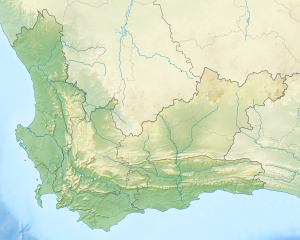| Chapman's Peak Drive | |
|---|---|
 Chapman's Peak Drive facing southwards. | |
| Length | 9.5 km |
| Traversed by | M6 |
| Location | Cape Peninsula, Western Cape, South Africa |
| Range | Table Mountain |
| Coordinates | 34°5′14″S 18°21′38″E / 34.08722°S 18.36056°E |
 Location of Chapman's Peak Drive in the Western Cape Province. | |
Chapman's Peak is a mountain on the western side of the Cape Peninsula, between Hout Bay and Noordhoek in Cape Town, South Africa. The western flank of the mountain falls sharply for hundreds of metres into the Atlantic Ocean, and a road, known as Chapman's Peak Drive, hugs the near-vertical face of the mountain, linking Hout Bay to Noordhoek. Tourists and locals often stop at viewpoints along this road, which offer views of Hout Bay, The Sentinel peak and surrounds, as well as over Noordhoek Beach.
Chapman's Peak Drive is part of the route of two of South Africa's biggest mass-participation races, the Cape Argus Cycle Race and the Two Oceans Marathon.
YouTube Encyclopedic
-
1/3Views:62 40513 7625 666
-
Driving around Cape Town - Chapman's Peak
-
Chapmans Peak Drive, Cape Town, An Aerial View
-
Chapman's Peak Drive (North) - Cape Town, South Africa
Transcription
History

Chapman's Peak is named after John Chapman, the pilot of an English ship becalmed in today's Hout Bay in 1607. The skipper sent his pilot ashore to find provisions, and the name was recorded as Chapman's Chaunce.[2]

Chapman's Peak Drive was hacked out of the face of the mountain between 1915 and 1922, and at the time was regarded as a major feat of engineering. The road was closed in the 1990s, after a rockfall caused a death and a subsequent lawsuit,[3] and subsequently reopened after being re-engineered to protect motorists from falling rocks. It was reopened in 2005 as a toll road, part of the M6. The road was again closed for a number of months beginning on 19 June 2008 "as a result of risk areas identified on the mountain above the road".[4]
Geology

The top of Chapman's Peak consists of flat, sedimentary rocks related to those that form Table Mountain. The base of the mountain, however, consists of Cape Granite and the two formations meet at a geological unconformity that is world-famous amongst earth scientists.
Two different endangered vegetation types can be found along this road, and correspond to the two main geological formations. They are Peninsula Sandstone Fynbos and Cape Granite Fynbos and they are both endemic to the city of Cape Town, occurring nowhere else.[5][6]
There is an old, abandoned manganese mine on the northwestern slopes of the peak. The remains of a jetty from which the ore used to be shipped are directly below the workings.
Gallery
-
Chapman's Peak Drive leading down to Hout Bay
-
Sunset at Hout Bay viewed from Chapman's Peak Drive
-
Before sunset at Hout Bay viewed from Chapman's Peak Drive
-
Chapman's Peak Drive sign
-
Rockfall shelters on Chapman's Peak Drive
-
Chapman's Peak, seen from Noordhoek
-
Video of Chapman's Peak Drive
-
Chapman's Peak Drive heading south from Hout Bay
-
Chapman’s Peak Hiking Trail
-
Hout Bay Harbour seen from The Hiking Trail
-
References
- ^ Drive, Chapman's Peak. "History". Chapmans Peak Drive. Retrieved 1 July 2020.
- ^ "History of Chapman's Peak Drive". chapmanspeakdrive.co.za. Retrieved 4 June 2016.
- ^ "The BTA Chapman's Peak Fund". Retrieved 28 July 2017.
- ^ Chapman's Peak Drive
- ^ "Cape Granite Fynbos. Cape Town Biodiversity Factsheets" (PDF). Archived from the original (PDF) on 3 August 2017. Retrieved 3 August 2017.
- ^ "Peninsula Sandstone Fynbos. Cape Town Biodiversity Factsheets" (PDF). Archived from the original (PDF) on 3 August 2017. Retrieved 3 August 2017.
External links
 Media related to Chapman’s Peak Drive at Wikimedia Commons
Media related to Chapman’s Peak Drive at Wikimedia Commons











